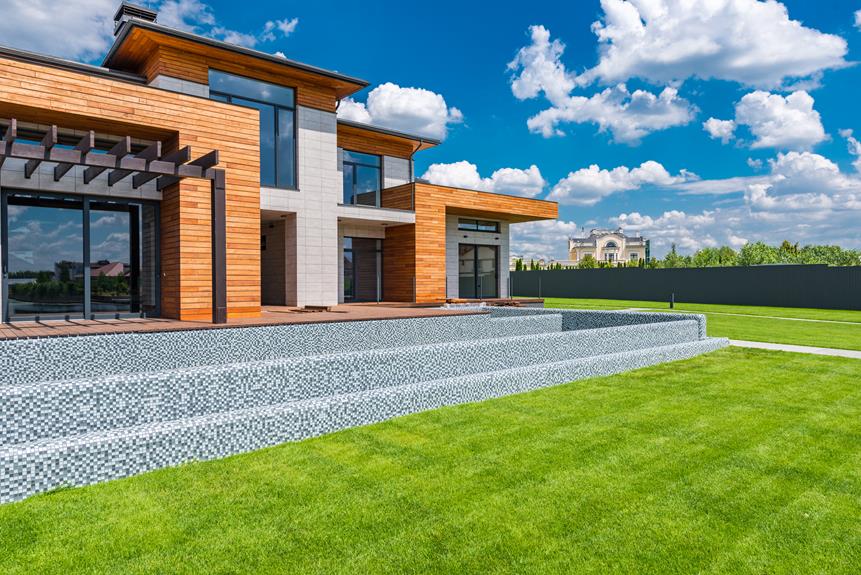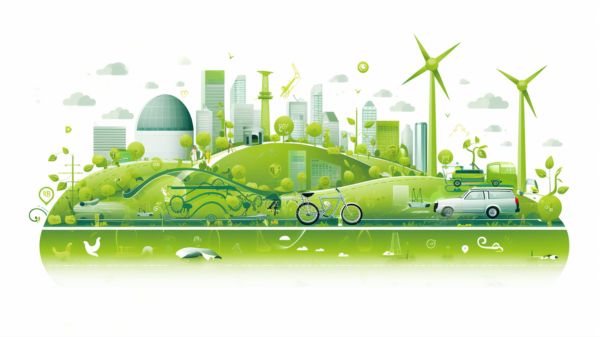14 Eco-friendly Suppliers for Green Building Materials
Looking to build green? Look no further than these 14 eco-friendly suppliers for green building material needs. From sustainable materials to energy-efficient insulation, you’ll find everything you need to create an environmentally friendly space.
Say goodbye to harmful chemicals and hello to low VOC paints and eco-friendly flooring options. With these suppliers, you can trust that you’re making a positive impact on the planet without sacrificing quality or style.
Get ready to build green and create a sustainable future.
Sustainable Materials
You should frequently consider purchasing sustainable materials when sourcing green building materials. Sustainable architecture and green building techniques prioritize the use of materials that have a minimal impact on the environment. These materials are designed to reduce waste, conserve energy, and promote the health and well-being of occupants.
When selecting sustainable materials, it’s important to consider their lifecycle impact, durability, and recyclability. By choosing materials that are made from renewable resources, such as bamboo or reclaimed wood, you can contribute to the reduction of deforestation and promote the use of renewable resources.
Additionally, opting for materials that are low in volatile organic compounds (VOCs) can improve indoor air quality and promote a healthier living environment. Sustainable materials play a crucial role in creating environmentally-friendly and energy-efficient buildings.
Recycled Building Products
When it comes to green building, using recycled building products offers several benefits. Not only does it reduce the demand for new materials, but it also helps to divert waste from landfills. Recycled products are readily available in the market, making it easy for builders and homeowners to incorporate sustainable practices into their projects.
Benefits of Using Recycled Materials
Using recycled materials in your green building projects offers numerous benefits.
One of the main advantages of upcycling is that it helps reduce waste and conserve natural resources. By using recycled materials, you’re diverting waste from landfills and reducing the extraction of raw materials. This not only helps protect the environment but also promotes eco-friendly construction methods.
Additionally, using recycled materials can help lower the carbon footprint of your building project. The production of new materials often requires a significant amount of energy and emits greenhouse gases. By opting for recycled building products, you’re contributing to a more sustainable future by reducing energy consumption and carbon emissions.
Availability of Recycled Products
To find recycled building products, start by exploring eco-friendly suppliers. These suppliers specialize in providing environmentally friendly alternatives to traditional construction materials. Here are some options available to you:
- Recycled lumber: Using reclaimed wood not only reduces the demand for new timber but also gives a unique character to your construction projects.
- Recycled concrete: Crushed concrete can be used as a base material for driveways, sidewalks, and other construction applications.
- Recycled glass: Glass can be recycled into countertops, tiles, and decorative elements, adding a touch of elegance to your designs.
- Recycled steel: Incorporating recycled steel into your construction projects reduces the need for new steel production and saves energy.
- Recycled insulation: Choose insulation made from recycled materials like denim, newspaper, or cellulose fibers to improve energy efficiency while reducing waste.
While finding recycled product alternatives is becoming easier, challenges in sourcing recycled materials still exist. However, by working with eco-friendly suppliers who prioritize sustainability, you can contribute to a greener and more sustainable construction industry.
Energy-Efficient Insulation
You can find a variety of energy-efficient insulation options from eco-friendly suppliers. When it comes to creating an energy-efficient home, insulation plays a crucial role in reducing heat loss and maintaining comfortable indoor temperatures.
Many eco-friendly suppliers offer insulation materials that are designed to be both effective and environmentally friendly. These materials are often made from sustainable or recycled materials, ensuring that they’ve a minimal impact on the environment.
Additionally, energy-efficient insulation can help to reduce energy consumption and lower utility bills. By properly insulating your home, you can create a more comfortable living space while also reducing your carbon footprint.
Some popular options for energy-efficient insulation include cellulose insulation, spray foam insulation, and recycled denim insulation. These materials provide excellent thermal resistance and help to create a more energy-efficient and eco-friendly home.
Low VOC Paints
When it comes to creating an eco-friendly and healthy indoor environment, it’s important to consider low VOC paints. These paints contain low levels of volatile organic compounds (VOCs), which are harmful chemicals that can be released into the air during the painting process and even years after. By choosing low VOC paints, you can reduce your exposure to toxic fumes and contribute to a greener and healthier home.
Here are five reasons why you should opt for non-toxic coatings and eco-friendly varnishes:
- Improved Air Quality: Low VOC paints emit fewer harmful chemicals, leading to better indoor air quality.
- Health Benefits: Using low VOC paints can help reduce respiratory problems, allergies, and eye irritation.
- Environmental Friendly: These paints have lower environmental impact as they contain fewer harmful chemicals.
- Odorless Application: Low VOC paints have reduced or no odor, making the painting process more pleasant.
- Long-lasting Performance: Despite being eco-friendly, these paints still offer excellent coverage and durability.
Eco-Friendly Flooring
When it comes to eco-friendly flooring options, there are several choices available to consider. These sustainable flooring options not only contribute to a greener environment but also offer numerous benefits.
From reducing indoor air pollution to conserving natural resources, eco-flooring is a smart choice for environmentally conscious individuals.
In this article, we’ll discuss the benefits of eco-friendly flooring and explore some of the best green flooring choices on the market.
Sustainable Flooring Options
Consider bamboo as a sustainable flooring option when looking for eco-friendly materials. Bamboo flooring is a popular choice due to its environmental benefits and durability. Here are some reasons why bamboo flooring is a great choice for your sustainable home:
- Renewable Resource: Bamboo is a fast-growing grass that can be harvested in just 5-7 years, making it a highly renewable resource.
- Water Resistant: Bamboo flooring is naturally water-resistant, making it a suitable option for areas prone to moisture.
- Cost-Effective Alternative: Bamboo flooring offers a cost-effective alternative to traditional hardwood floors, providing a similar aesthetic at a lower price.
- Low Emissions: Bamboo flooring has low formaldehyde emissions, ensuring a healthier indoor air quality.
- Easy Maintenance: Bamboo flooring is easy to clean and maintain, requiring simple dusting or sweeping to keep it looking fresh.
When choosing sustainable flooring options, bamboo is a top choice that combines eco-friendliness, durability, and affordability.
Benefits of Eco-Flooring
Choose eco-flooring for your sustainable home and enjoy the numerous benefits it offers.
Eco-flooring, also known as eco-friendly flooring, refers to flooring options that are made from sustainable and environmentally friendly materials.
One of the main benefits of eco-flooring is its positive impact on the environment. By using eco-friendly options, you’re reducing the demand for natural resources and minimizing the carbon footprint associated with the production and disposal of traditional flooring materials.
Additionally, eco-flooring is often made from recycled or renewable materials, further reducing waste and promoting a circular economy.
Another benefit is improved indoor air quality. Many traditional flooring materials contain harmful chemicals that can release toxins into the air, whereas eco-flooring is non-toxic and doesn’t emit harmful VOCs.
Lastly, eco-flooring is durable and long-lasting, saving you money on replacements and reducing waste over time.
Choose eco-flooring for a sustainable and healthy home.
Best Green Flooring Choices
To continue your sustainable home journey, explore the best green flooring choices available to you. When it comes to eco-friendly flooring options, there are several benefits to using green flooring in your home. Here are five options to consider:
- Cork Flooring: Made from the bark of the cork oak tree, this flooring is renewable and offers thermal and acoustic insulation.
- Bamboo Flooring: Fast-growing and renewable, bamboo flooring is durable and can be harvested without harming the plant.
- Reclaimed Wood Flooring: Salvaged from old buildings, this flooring option reduces waste and adds a unique character to your home.
- Linoleum Flooring: Made from natural materials like linseed oil and cork powder, linoleum is biodegradable and low in VOC emissions.
- Recycled Carpet Tiles: Made from recycled materials, these tiles are easy to install and replace, while reducing landfill waste.
Consider these green flooring options to create a sustainable and environmentally-friendly home.
Water Conservation Solutions
How can you effectively conserve water when choosing suppliers for green building materials?
Water conservation is an essential aspect of sustainable construction. When selecting suppliers, it’s crucial to consider their commitment to water-saving technologies and practices. Look for suppliers that offer products that promote water conservation, such as low-flow fixtures and water-efficient appliances.
Additionally, consider suppliers that support rainwater harvesting systems, which collect and store rainwater for non-potable uses like irrigation and toilet flushing. By incorporating these water-saving technologies and practices into your building project, you can reduce water consumption and minimize environmental impact.
Choosing suppliers that prioritize water conservation not only helps preserve our precious water resources but also contributes to creating a more sustainable and eco-friendly built environment.
Green Roofing Materials
When considering suppliers for eco-friendly building materials, it’s important to explore the benefits of utilizing green roofing materials. Green roofing installation offers numerous advantages that contribute to a more sustainable and environmentally friendly construction project. Here are some key benefits to consider:
- Increased energy efficiency: Green roofs provide insulation, reducing the need for heating and cooling, thus lowering energy consumption.
- Storm-water management: Green roofs absorb rainwater, reducing the strain on drainage systems and preventing water runoff.
- Improved air quality: Vegetation on green roofs helps to filter pollutants and improve air quality in urban areas.
- Noise reduction: Green roofs act as sound barriers, reducing noise pollution from outside sources.
- Extended roof lifespan: The vegetation layer on green roofs protects the roofing membrane from UV radiation and extreme temperatures, prolonging its lifespan.
When selecting eco-friendly roofing options, these benefits demonstrate the value and positive impact of incorporating green roofing materials into your construction project.
Renewable Energy Systems
You can incorporate renewable energy systems into your construction project for a more sustainable and environmentally friendly building. Renewable energy systems utilize sources such as solar, wind, and geothermal power to generate electricity or heat. These systems offer several benefits, including reduced reliance on fossil fuels, lower energy costs, and decreased greenhouse gas emissions.
Incorporating renewable energy systems can also help you achieve green building certification programs such as LEED (Leadership in Energy and Environmental Design) or Green Globes. These programs recognize buildings that meet certain sustainability criteria, including the use of renewable energy.
When choosing renewable energy systems, consider factors such as the availability of renewable resources in your area, the specific energy needs of your building, and the potential for long-term cost savings.
Zero Waste Construction Supplies
To further promote sustainability in your construction project, consider incorporating zero waste construction supplies. These supplies are designed to minimize waste and reduce the environmental impact of your project. By using zero waste construction methods, you can significantly reduce the amount of construction waste that ends up in landfills.
Here are five examples of zero waste construction supplies that can help you achieve your sustainability goals:
- Recycled building materials: Using materials made from recycled content helps reduce the demand for new resources and minimizes waste.
- Prefabricated components: Prefabricated components are manufactured off-site, resulting in less waste and a more efficient construction process.
- Reusable formwork systems: Reusable formwork systems eliminate the need for disposable forms, reducing waste and increasing efficiency.
- Integrated waste management systems: Implementing integrated waste management systems ensures that waste is properly sorted, recycled, or repurposed on-site.
- Salvaged materials: Incorporating salvaged materials into your construction project not only reduces waste but also adds a unique and sustainable touch.
Non-Toxic Sealants and Adhesives
When it comes to non-toxic sealants and adhesives for green building materials, there are a variety of sustainable options available.
These options not only provide a more eco-friendly alternative to traditional sealants and adhesives, but they also offer health benefits.
Non-toxic sealants and adhesives can help improve indoor air quality by reducing the release of harmful chemicals, making them a safer choice for both the environment and the people using them.
Sustainable Adhesive Options
For environmentally conscious builders seeking non-toxic sealants and adhesives, there are several sustainable options available from eco-friendly suppliers. When it comes to sustainable adhesive options, you have a range of choices that not only ensure a secure bond but also prioritize the health of both the environment and the people living or working in the building. Here are five eco-friendly adhesive alternatives to consider for your sustainable flooring installation:
- Soy-based adhesives: Made from renewable soybeans, these adhesives are non-toxic and emit fewer volatile organic compounds (VOCs).
- Water-based adhesives: These adhesives are solvent-free and contain low levels of VOCs, making them a safer choice for indoor air quality.
- Recycled content adhesives: These adhesives are made from recycled materials, reducing landfill waste and conserving natural resources.
- Bio-based adhesives: Derived from natural sources like corn, these adhesives are biodegradable and have a lower environmental impact.
- Green building certifications: Look for adhesives that meet rigorous sustainability standards such as LEED or BREEAM.
Health Benefits of Non-Toxic Sealants
By using non-toxic sealants and adhesives, you can significantly improve the health of both the environment and the people living or working in the building. These eco-friendly alternatives offer numerous health benefits that make them a better choice compared to conventional sealants.
Non-toxic sealants are made from natural ingredients, avoiding harmful chemicals that can release toxic fumes into the air. This reduces the risk of respiratory problems, allergies, and other health issues caused by indoor air pollution.
Additionally, non-toxic sealants are safer to handle and apply, reducing the chances of skin irritation or harmful chemical exposure.
Choosing these eco-friendly alternatives not only promotes a healthier living or working environment but also contributes to a sustainable and greener future.
Environmentally Friendly Plumbing Fixtures
You can find a variety of environmentally friendly plumbing fixtures from eco-friendly suppliers. These fixtures are designed to not only conserve water but also reduce the overall environmental impact. Here are five water-efficient and eco-friendly plumbing materials that you might consider:
- Low-flow toilets: These toilets use less water per flush, resulting in significant water savings over time.
- Water-saving showerheads: These showerheads limit the amount of water used while still providing a satisfying shower experience.
- Faucet aerators: By adding air to the water flow, faucet aerators reduce water consumption without compromising on performance.
- Dual-flush toilets: These toilets offer different flush options for liquid waste and solid waste, allowing for greater water conservation.
- Greywater systems: These systems collect and treat water from sinks, showers, and washing machines, making it suitable for non-potable uses like irrigation.
Natural Stone and Wood Products
When it comes to natural stone and wood products for green building, it’s important to consider sustainable sourcing practices. Understanding where these materials come from and how they’re harvested can help you make environmentally responsible choices.
Additionally, conducting an environmental impact assessment can provide valuable information about the carbon footprint and overall sustainability of these materials.
Sustainable Sourcing Practices
When sourcing materials such as natural stone and wood products for your green building project, it’s essential to prioritize sustainable practices. By opting for sustainable procurement and fair trade suppliers, you can ensure that the materials used in your project are sourced responsibly.
Here are five reasons why sustainable sourcing practices are crucial:
- Conservation of natural resources: By sourcing materials from sustainable suppliers, you contribute to the preservation of natural resources, protecting ecosystems and biodiversity.
- Reduction of environmental impact: Sustainable sourcing practices focus on minimizing carbon emissions, water usage, and waste generation, helping to mitigate climate change and pollution.
- Support for local communities: Fair trade suppliers often work directly with local communities, providing them with fair wages and supporting their economic development.
- Ethical treatment of workers: Sustainable sourcing practices prioritize safe working conditions and fair labor practices, ensuring the well-being of workers involved in the production of materials.
- Long-term viability: By choosing sustainable sourcing practices, you contribute to the long-term viability of the industry, promoting a more sustainable and resilient future.
Environmental Impact Assessment
To assess the environmental impact of natural stone and wood products, it’s important to conduct an environmental impact assessment. This assessment is a crucial step in ensuring that these materials meet green building regulations and contribute to environmental impact mitigation.
A comprehensive environmental impact assessment examines various factors, such as the extraction process, transportation, and manufacturing of these materials. It evaluates the energy consumption, carbon emissions, and waste generated throughout their lifecycle. By conducting this assessment, you can identify potential environmental risks and develop strategies to minimize them.
Additionally, it enables you to compare different suppliers and choose those that adhere to sustainable practices. By incorporating environmental impact assessments into your evaluation process, you can make informed decisions and support suppliers who prioritize eco-friendly practices in the production of natural stone and wood products.
Benefits of Natural Materials
Using natural materials, such as natural stone and wood products, can provide numerous benefits for your green building projects. Here are some advantages of sustainable materials:
- Durability: Natural stone and wood products are known for their longevity, ensuring that your buildings will stand the test of time.
- Energy Efficiency: These materials have excellent thermal properties, helping to regulate temperature and reduce the need for artificial heating and cooling.
- Health and Well-being: Natural materials promote better indoor air quality by minimizing the release of harmful chemicals and allergens.
- Aesthetics: Natural stone and wood products add a timeless and elegant touch to any space, creating a warm and inviting atmosphere.
- Sustainability: Using natural materials reduces the environmental impact of your construction projects, as they’re renewable, recyclable, and biodegradable.
Sustainable Lighting Solutions
For sustainable lighting solutions, you can rely on suppliers that specialize in eco-friendly materials. These suppliers offer a wide range of options, including energy-efficient bulbs and solar-powered lighting.
Energy-efficient bulbs, such as LED lights, use significantly less energy than traditional incandescent bulbs, reducing both your carbon footprint and your electricity bills.
Solar-powered lighting harnesses the power of the sun to provide lighting without relying on electricity. This not only reduces your energy consumption but also allows for greater flexibility in lighting placement, as solar-powered lights can be installed in areas without access to electrical outlets.
Green Building Certification Programs
Consider utilizing green building certification programs to ensure the sustainability and environmental performance of your construction projects. These programs provide a comprehensive framework for evaluating and verifying the green attributes of a building, ensuring that it meets the highest standards of eco-friendliness.
Here are five reasons why you should consider these programs:
- Boost your reputation: Achieving green building certification demonstrates your commitment to sustainability, enhancing your reputation as an environmentally responsible company.
- Access to incentives: Many green building certification programs offer financial incentives, such as tax credits and grants, to encourage the adoption of eco-friendly construction methods.
- Higher resale value: Green-certified buildings often command higher resale values, attracting environmentally conscious buyers and investors.
- Health and well-being: Green building standards prioritize occupant health and comfort, creating healthier indoor environments with improved air quality and natural lighting.
- Future-proofing: By incorporating eco-friendly construction methods, you future-proof your building against changing regulations and increasing demand for sustainable spaces.
Conclusion
These 14 eco-friendly suppliers offer a wide range of green building materials, making it easier for individuals and businesses to construct sustainable and environmentally friendly structures.
By using sustainable materials, recycled products, energy-efficient insulation, low VOC paints, eco-friendly flooring, and other environmentally friendly options, builders can reduce their carbon footprint and contribute to a greener future.
With the help of these suppliers and their commitment to sustainability, the construction industry can make significant strides towards a more environmentally conscious approach.






